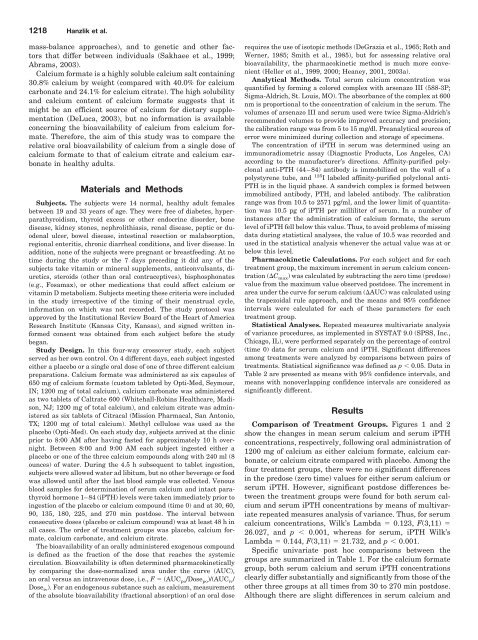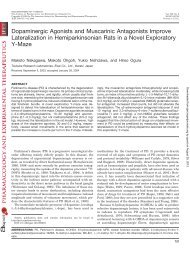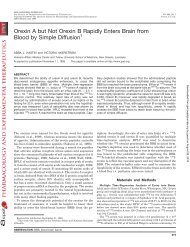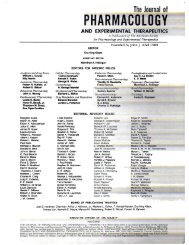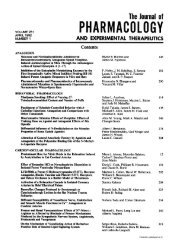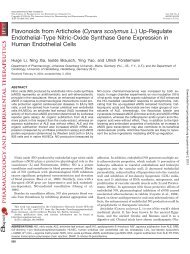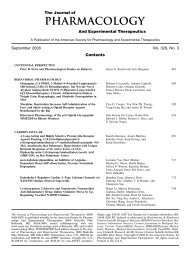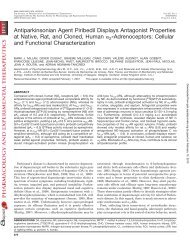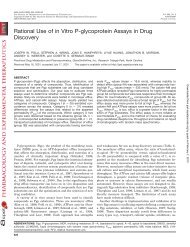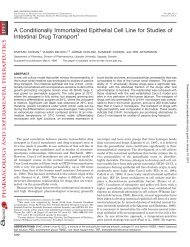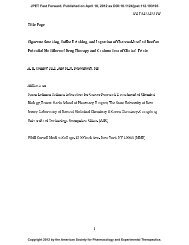Relative Bioavailability of Calcium from Calcium Formate, Calcium ...
Relative Bioavailability of Calcium from Calcium Formate, Calcium ...
Relative Bioavailability of Calcium from Calcium Formate, Calcium ...
You also want an ePaper? Increase the reach of your titles
YUMPU automatically turns print PDFs into web optimized ePapers that Google loves.
1218 Hanzlik et al.<br />
mass-balance approaches), and to genetic and other factors<br />
that differ between individuals (Sakhaee et al., 1999;<br />
Abrams, 2003).<br />
<strong>Calcium</strong> formate is a highly soluble calcium salt containing<br />
30.8% calcium by weight (compared with 40.0% for calcium<br />
carbonate and 24.1% for calcium citrate). The high solubility<br />
and calcium content <strong>of</strong> calcium formate suggests that it<br />
might be an efficient source <strong>of</strong> calcium for dietary supplementation<br />
(DeLuca, 2003), but no information is available<br />
concerning the bioavailability <strong>of</strong> calcium <strong>from</strong> calcium formate.<br />
Therefore, the aim <strong>of</strong> this study was to compare the<br />
relative oral bioavailability <strong>of</strong> calcium <strong>from</strong> a single dose <strong>of</strong><br />
calcium formate to that <strong>of</strong> calcium citrate and calcium carbonate<br />
in healthy adults.<br />
Materials and Methods<br />
Subjects. The subjects were 14 normal, healthy adult females<br />
between 19 and 33 years <strong>of</strong> age. They were free <strong>of</strong> diabetes, hyperparathyroidism,<br />
thyroid excess or other endocrine disorder, bone<br />
disease, kidney stones, nephrolithiasis, renal disease, peptic or duodenal<br />
ulcer, bowel disease, intestinal resection or malabsorption,<br />
regional enteritis, chronic diarrheal conditions, and liver disease. In<br />
addition, none <strong>of</strong> the subjects were pregnant or breastfeeding. At no<br />
time during the study or the 7 days preceding it did any <strong>of</strong> the<br />
subjects take vitamin or mineral supplements, anticonvulsants, diuretics,<br />
steroids (other than oral contraceptives), bisphosphonates<br />
(e.g., Fosamax), or other medications that could affect calcium or<br />
vitamin D metabolism. Subjects meeting these criteria were included<br />
in the study irrespective <strong>of</strong> the timing <strong>of</strong> their menstrual cycle,<br />
information on which was not recorded. The study protocol was<br />
approved by the Institutional Review Board <strong>of</strong> the Heart <strong>of</strong> America<br />
Research Institute (Kansas City, Kansas), and signed written informed<br />
consent was obtained <strong>from</strong> each subject before the study<br />
began.<br />
Study Design. In this four-way crossover study, each subject<br />
served as her own control. On 4 different days, each subject ingested<br />
either a placebo or a single oral dose <strong>of</strong> one <strong>of</strong> three different calcium<br />
preparations. <strong>Calcium</strong> formate was administered as six capsules <strong>of</strong><br />
650 mg <strong>of</strong> calcium formate (custom tableted by Opti-Med, Seymour,<br />
IN; 1200 mg <strong>of</strong> total calcium), calcium carbonate was administered<br />
as two tablets <strong>of</strong> Caltrate 600 (Whitehall-Robins Healthcare, Madison,<br />
NJ; 1200 mg <strong>of</strong> total calcium), and calcium citrate was administered<br />
as six tablets <strong>of</strong> Citracal (Mission Pharmacal, San Antonio,<br />
TX; 1200 mg <strong>of</strong> total calcium). Methyl cellulose was used as the<br />
placebo (Opti-Med). On each study day, subjects arrived at the clinic<br />
prior to 8:00 AM after having fasted for approximately 10 h overnight.<br />
Between 8:00 and 9:00 AM each subject ingested either a<br />
placebo or one <strong>of</strong> the three calcium compounds along with 240 ml (8<br />
ounces) <strong>of</strong> water. During the 4.5 h subsequent to tablet ingestion,<br />
subjects were allowed water ad libitum, but no other beverage or food<br />
was allowed until after the last blood sample was collected. Venous<br />
blood samples for determination <strong>of</strong> serum calcium and intact parathyroid<br />
hormone 1–84 (iPTH) levels were taken immediately prior to<br />
ingestion <strong>of</strong> the placebo or calcium compound (time 0) and at 30, 60,<br />
90, 135, 180, 225, and 270 min postdose. The interval between<br />
consecutive doses (placebo or calcium compound) was at least 48 h in<br />
all cases. The order <strong>of</strong> treatment groups was placebo, calcium formate,<br />
calcium carbonate, and calcium citrate.<br />
The bioavailability <strong>of</strong> an orally administered exogenous compound<br />
is defined as the fraction <strong>of</strong> the dose that reaches the systemic<br />
circulation. <strong>Bioavailability</strong> is <strong>of</strong>ten determined pharmacokinetically<br />
by comparing the dose-normalized area under the curve (AUC),<br />
an oral versus an intravenous dose, i.e., F (AUC po /Dose po )/(AUC iv /<br />
Dose iv ). For an endogenous substance such as calcium, measurement<br />
<strong>of</strong> the absolute bioavailability (fractional absorption) <strong>of</strong> an oral dose<br />
requires the use <strong>of</strong> isotopic methods (DeGrazia et al., 1965; Roth and<br />
Werner, 1985; Smith et al., 1985), but for assessing relative oral<br />
bioavailability, the pharmacokinetic method is much more convenient<br />
(Heller et al., 1999, 2000; Heaney, 2001, 2003a).<br />
Analytical Methods. Total serum calcium concentration was<br />
quantified by forming a colored complex with arsenazo III (588-3P;<br />
Sigma-Aldrich, St. Louis, MO). The absorbance <strong>of</strong> the complex at 600<br />
nm is proportional to the concentration <strong>of</strong> calcium in the serum. The<br />
volumes <strong>of</strong> arsenazo III and serum used were twice Sigma-Aldrich’s<br />
recommended volumes to provide improved accuracy and precision;<br />
the calibration range was <strong>from</strong> 5 to 15 mg/dl. Preanalytical sources <strong>of</strong><br />
error were minimized during collection and storage <strong>of</strong> specimens.<br />
The concentration <strong>of</strong> iPTH in serum was determined using an<br />
immunoradiometric assay (Diagnostic Products, Los Angeles, CA)<br />
according to the manufacturer’s directions. Affinity-purified polyclonal<br />
anti-PTH (44–84) antibody is immobilized on the wall <strong>of</strong> a<br />
polystyrene tube, and 125 I labeled affinity-purified polyclonal anti-<br />
PTH is in the liquid phase. A sandwich complex is formed between<br />
immobilized antibody, PTH, and labeled antibody. The calibration<br />
range was <strong>from</strong> 10.5 to 2571 pg/ml, and the lower limit <strong>of</strong> quantitation<br />
was 10.5 pg <strong>of</strong> iPTH per milliliter <strong>of</strong> serum. In a number <strong>of</strong><br />
instances after the administration <strong>of</strong> calcium formate, the serum<br />
level <strong>of</strong> iPTH fell below this value. Thus, to avoid problems <strong>of</strong> missing<br />
data during statistical analyses, the value <strong>of</strong> 10.5 was recorded and<br />
used in the statistical analysis whenever the actual value was at or<br />
below this level.<br />
Pharmacokinetic Calculations. For each subject and for each<br />
treatment group, the maximum increment in serum calcium concentration<br />
(C max ) was calculated by subtracting the zero time (predose)<br />
value <strong>from</strong> the maximum value observed postdose. The increment in<br />
area under the curve for serum calcium (AUC) was calculated using<br />
the trapezoidal rule approach, and the means and 95% confidence<br />
intervals were calculated for each <strong>of</strong> these parameters for each<br />
treatment group.<br />
Statistical Analyses. Repeated measures multivariate analysis<br />
<strong>of</strong> variance procedures, as implemented in SYSTAT 9.0 (SPSS, Inc.,<br />
Chicago, IL), were performed separately on the percentage <strong>of</strong> control<br />
(time 0) data for serum calcium and iPTH. Significant differences<br />
among treatments were analyzed by comparisons between pairs <strong>of</strong><br />
treatments. Statistical significance was defined as p 0.05. Data in<br />
Table 2 are presented as means with 95% confidence intervals, and<br />
means with nonoverlapping confidence intervals are considered as<br />
significantly different.<br />
Results<br />
Comparison <strong>of</strong> Treatment Groups. Figures 1 and 2<br />
show the changes in mean serum calcium and serum iPTH<br />
concentrations, respectively, following oral administration <strong>of</strong><br />
1200 mg <strong>of</strong> calcium as either calcium formate, calcium carbonate,<br />
or calcium citrate compared with placebo. Among the<br />
four treatment groups, there were no significant differences<br />
in the predose (zero time) values for either serum calcium or<br />
serum iPTH. However, significant postdose differences between<br />
the treatment groups were found for both serum calcium<br />
and serum iPTH concentrations by means <strong>of</strong> multivariate<br />
repeated measures analysis <strong>of</strong> variance. Thus, for serum<br />
calcium concentrations, Wilk’s Lambda 0.123, F(3,11) <br />
26.027, and p 0.001, whereas for serum, iPTH Wilk’s<br />
Lambda 0.144, F(3,11) 21.732, and p 0.001.<br />
Specific univariate post hoc comparisons between the<br />
groups are summarized in Table 1. For the calcium formate<br />
group, both serum calcium and serum iPTH concentrations<br />
clearly differ substantially and significantly <strong>from</strong> those <strong>of</strong> the<br />
other three groups at all times <strong>from</strong> 30 to 270 min postdose.<br />
Although there are slight differences in serum calcium and


